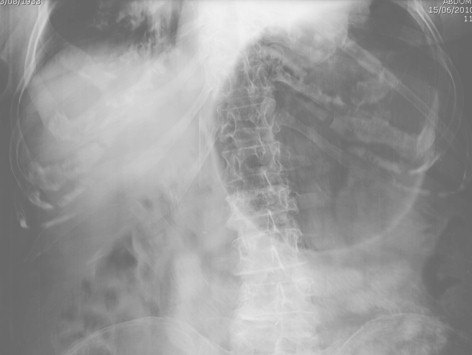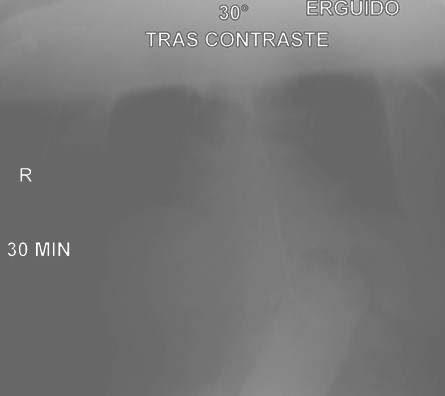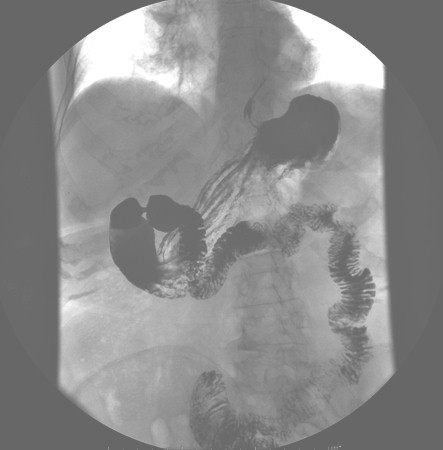Volvulo gastrico agudo. Caso clinico .2

Foto 4

Foto 5

Foto 6
CLINICAL CASE
77 years old female with a history of penicillin allergy, hypertension, bronchial hyperreactivity, Parkinson's disease, bed-chair dependent life and operated on his left shoulder and left knee prosthesis.
Go to the emergency room coffee-ground vomiting.
On examination the abdomen was soft and palpable epigastric painful without peritonitis and normal stool in the rectal ampulla.
In the chest X-ray: air bubble above the diaphragm (Photo 1) or retrocardiac mass (Photo 2).
She underwent an upper endoscopy which showed a suspected diagnosis of possible gastric volvulus due to a paraesophageal hernia.
A CT scan of the chest and abdomen, where show an important gastric hiatal hernia and organo-axial gastric torsion to thoracic level (Photo 3).
We attempted to tranfer the cardias with nasogastric tube to aspirate gastric contents in order to decrease bloating and reduce the hernia (Photo 4) to perform surgery as scheduled but it was not possible and an emergency surgery was decided.
At surgery showed promoted stomach and torsion in thoracic cavity. We proceeded to the reduction into the abdominal cavity, confirming the viability of the stomach, performing previous closure of the pillars and gastropexy to the anterior wall.
In the postoperative period did gastroduodenal transit (Photo 5) confirming the good passage of contrast and the indemnity of the digestive wall.
In reviewing in the consultation was again requested an endoscopy and gastroduodenal transit (Photo 6) turning to check the normal evacuation and the adequate location of the esophagogastric junction.
DISCUSIÓN
La hernia de hiato paraesofágica es una patología poco frecuente, y la volvulación del estomago emigrado aun menos habitual.
Esta volvulación suele presentarse especialmente en pacientes de edad avanzada y generalmente asociado a otras comorbilidades siendo su complicación más grave la estrangulación (5-28%) (1).
Quizás por ello, las hernias de hiato paraesofágicas de una debida entidad deben ser intervenidas de forma programada (2) para evitar entre otras el desarrollo de un vólvulo, su consecuente estrangulación y la intervención de urgencia en condiciones menos favorables.
Cuando se diagnostica un vólvulo gástrico en urgencias la intervención quirúrgica debe ser inmediata para evitar la estrangulación e isquemia del segmento volvulado.
Lo cual no debe impedir el que con anterioridad se trate de provocar una descompresión con sonda nasogástrica que permita la resolución de la urgencia quirúrgica y el paso a cirugía diferida (1, 2 ,3).
DISCUSSION
Paraesophageal hiatal hernia is an infrequent disease, and gastric volvulus migrated even less common.
This gastric volvulus usually presents especially in elderly patients and generally associated with other comorbidities, being the strangulation its most serious complication (5-28%) (1).
Maybe due to it, paraesophageal hiatal hernias of a definite entity should be operated from elective form (2) to avoid among others the development of a volvulus, its consequent strangulation and the emergency intervention in conditions less advantageous.
In urgency sala when it is perform a diagnosis of a gastric volvulus, emergency surgical intervention should be immediate to prevent strangulation and the segment ischemia twisted.
This should not prevent that previously attempt cause a decompression with a nasogastric tube that allows the resolution of the emergency surgical and the transition to delayed surgery (1, 2, 3).
BIBLIOGRAFÍA
1. Morales C. H., Hoyo S.. Vólvulo gástrico agudo: Etiopatogénesis, diagnóstico y tratamiento. IATREIA 1997; 10 (3): 127-32.
2. Sánchez Y. L. y Fernández I. P.. Vólvulo gástrico como causa infrecuente de dolor abdominal. Rev. esp. enferm. dig. vol. 101 no.7 Madrid July 2009.
3. Melguizo M. MD. Gran hernia paraesofágica con estómago intratorácico total. Informe de un caso y revisión de la literatura. Rev Col Gastroenterol. 2006; 21 (1): 64-7.